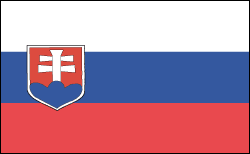Slovakia | Facts & Information

- Slovakia Profile
- History
- News and Current Events
Infoplease has everything you need to know about Slovakia. Check out our country profile, full of essential information about Slovakia's geography, history, government, economy, population, culture, religion and languages. If that's not enough, click over to our collection of world maps and flags.
Facts & Figures
-
President: Zuzana Caputova (2019)
Prime Minister: Eduard Heger (2021)
Land area: 18,842 sq mi (48,800 sq km); total area: 18,859 sq mi (48,845 sq km)
Population (2022 est.): 5,431,252 (growth rate: -0.1%); birth rate: 8.94/1000; infant mortality rate: 4.82/1000; life expectancy: 78.31
Capital and largest city (2022 est.): Bratislava, 439,000
Other large city: Kosice, 240,688
Monetary unit: Koruna
National name: Slovenska Republika
Languages: Slovak (official) 81.8%, Hungarian 8.5%, Roma 1.8%, other 2.2%, unspecified 5.7% (2021 est.)
Ethnicity/race: Slovak 83.8%, Hungarian 7.8%, Romani 1.2%, other 1.8% (includes Czech, Ruthenian, Ukrainian, Russian, German, Polish), unspecified 5.4% (2021 est.)
Religions: Roman Catholic 55.8%, Evangelical Church of the Augsburg Confession 5.3%, Greek Catholic 4%, Reformed Christian 1.6%, other 3%, none 23.8%, unspecified 6.5% (2021 est.)
Literacy rate: 99.6% (2004 est.)
Economic summary: GDP/PPP (2020 est.): $165.57 billion; per capita $30,300. Real growth rate: 2.4%. Inflation: 2.6%. Unemployment: 19.4% (2020 est.). Arable land: 28.9%. Agriculture: grains, potatoes, sugar beets, hops, fruit; pigs, cattle, poultry; forest products. Labor force: 2.511 million (2020 est.); agriculture 3.9%, industry 22.7%, services 73.4% (2015). Industries: metal and metal products; food and beverages; electricity, gas, coke, oil, nuclear fuel; chemicals, synthetic fibers; machinery; paper and printing; earthenware and ceramics; transport vehicles; textiles; electrical and optical apparatus; rubber products. Natural resources: brown coal and lignite; small amounts of iron ore, copper and manganese ore; salt; arable land. Exports: $89.92 billion (2020 est.): vehicles 21%, machinery and electrical equipment 35.9%, base metals 11.3%, chemicals and minerals 8.1%, plastics 4.9% (2009).Major trading partners (exports): Germany 22%, Czechia 11%, Poland 7%, France 7%, Hungary 6%, Austria 5%, United Kingdom 5% (2019). Imports: $87.95 billion (2020 est.): machinery and transport equipment 31%, mineral products 13%, vehicles 12%, base metals 9%, chemicals 8%, plastics 6% (2009). Major trading partners: Germany 18%, Czechia 18%, Poland 8%, Hungary 7%, Russia 5% (2019).
Communications: Telephones: main lines in use: 648,462 (2020); mobile cellular: 7,399,530 (2019). Radio broadcast stations: AM 15, FM 78, shortwave 2 (2008); state-owned public broadcaster, Radio and Television of Slovakia (RTVS), operates 2 national TV stations and multiple national and regional radio networks; roughly 50 privately owned TV stations operating nationally, regionally, and locally; about 40% of households are connected to multi-channel cable or satellite TV; 32 privately owned radio stations. Radios: 3.12 million (1997). Television broadcast stations: 38 (plus 864 repeaters) (1995). Televisions: 2.62 million (2008). Internet Service Providers (ISPs): 1.384 million (2012). Internet users: 4,917,528 (2022).
Transportation: Railways: total: 3,580 km (2016). Highways: total: 56,926 km; paved: 38,238 km (including 417 km of expressways); unpaved: 5,678 km (2016). Waterways: 172 km on the Danube. Ports and harbors: Bratislava, Komarno. Airports: 35 (2021).
International disputes: bilateral government, legal, technical and economic working group negotiations continued in 2006 between Slovakia and Hungary over Hungary's completion of its portion of the Gabcikovo-Nagymaros hydroelectric dam project along the Danube; as a member state that forms part of the EU's external border, Slovakia has implemented the strict Schengen border rules.









